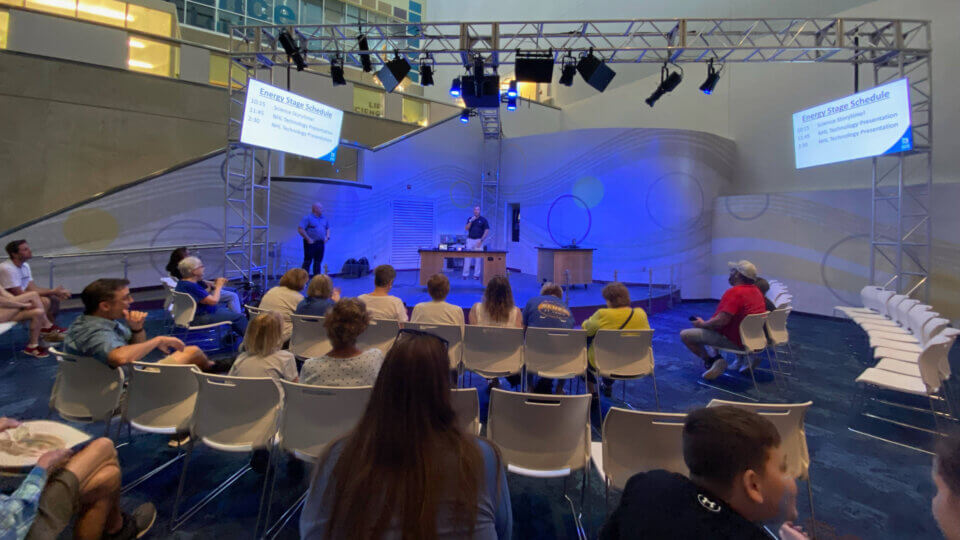On Sunday August 21, members of the NHL’s Technical Team were at the Saint Louis Science Center to discuss the evolution of technology used by players, coaches and referees to make in-game decisions. These experts showcased some of the technology used right here in St. Louis’ Enterprise Center during St. Louis Blues games. Guests had… Continue reading
Astronomy Fact of the Day: August 29, 2022
August 29, 2022 On this date in 1965, Gemini V returned to Earth following an 8-day orbital mission. Due to a programming error in their navigational computer, the astronauts had to guide the spacecraft to its splashdown manually. A recovery helicopter carries command pilot L. Gordon Cooper, Jr. from the Gemini V capsule after splashdown.… Continue reading
Astronomy Fact of the Day: August 28, 2022
August 28, 2022 On this date in 1789, William Herschel discovered Saturn’s sixth largest moon Enceladus. Herschel used his famous “Great Forty-Foot” telescope – with a 48 in diameter – for the initial discovery, and it wasn’t until the Voyager missions that humans were able to get a more detailed look at Enceladus. Voyager 2… Continue reading
Night Sky Update: August 26 – September 3, 2022
This is the Saint Louis Science Center’s NIGHT SKY UPDATE for the week of Friday, August 26, 2022. Information updated weekly or as needed. Times given as local St. Louis time which is Central Daylight Time (CDT). For definitions of terminology used in the night sky update, click the highlighted text. If relying on times… Continue reading
Astronomy Fact of the Day: August 27, 2022
August 27, 2022 This morning at 11 am, Mercury reaches greatest eastern elongation at 27°. When Mercury is at greatest elongation, it is at its greatest separation from the Sun. Mercury will be low in the west approximately 30 minutes after sunrise. A “true” color image of Mercury taken by the MESSENGER spacecraft. Image credit:… Continue reading
Astronomy Fact of the Day: August 26, 2022
August 26, 2022 A solar eclipse occurs when the Moon passes between the Earth and the Sun. Scientists throughout history have observed solar eclipses to learn more about the Sun, the Moon, and the rest of the solar system. On June 29, 2022, the Solar Dynamics Observatory (SDO) captured images of a partial solar eclipse… Continue reading
Astronomy Fact of the Day: August 25, 2022
August 25, 2022 This afternoon Venus, the Moon, and the dwarf planet Ceres will all be clustered together in the sky. At their closest Ceres is 0.7° north of the Moon and Venus is 4° south of Moon. Unfortunately, the closest arrangement of these objects will occur during the day and will not be visible.… Continue reading
Beaver Skull
Beaver Skull – Native to central and northern US, southern Canada The American beaver is the largest rodent in North America and mainly an aquatic animal, living in forested areas with freshwater lakes, rivers, and streams. As seen here, beaver teeth are overly large, and bright orange in color. The teeth grow throughout its life… Continue reading
Astronomy Fact of the Day: August 24, 2022
August 24, 2022 On this date in 1960, McDonnell Aircraft proposed a One-Man Space Station to the Space Task Group at NASA facilities. The idea behind this station was to build a 10-ft long, 6-ft wide cylinder that could attach to the Mercury spacecraft. The station was only intended to be inhabited for 14 days… Continue reading
Astronomy Fact of the Day: August 23, 2022
August 23, 2022 You can look towards the center of the Milky Way Galaxy by looking south tonight at 9 pm. Just find the “teapot” group of stars in the constellation Sagittarius. The galaxy’s center is just above the spout of the teapot. With extremely dark skies it is possible to see the central plane… Continue reading








